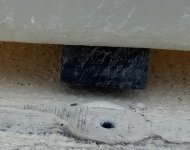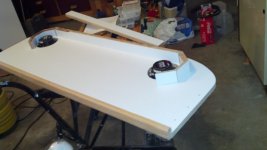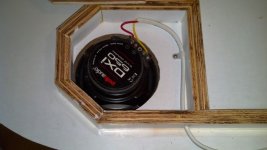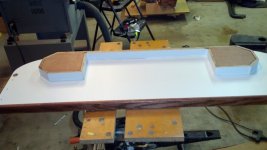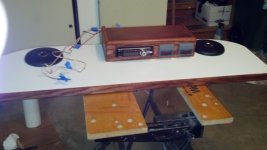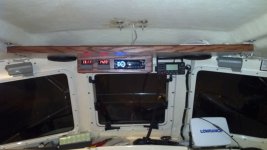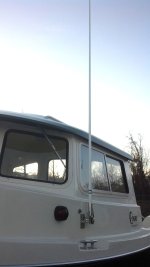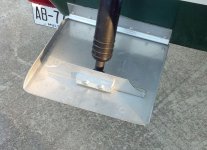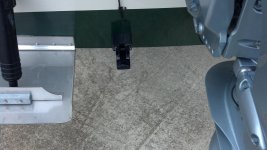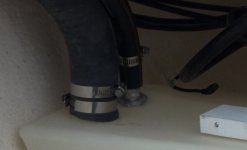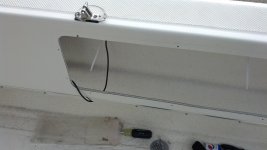Sunbeam":57bjjbmu said:
I don't mean to sound like a broken record (especially if you have already done this), but did you take any extra steps to seal off the transom core? I mean beyond caulk? I would personally take additional measures (overdrill, ream out core, fill with thickened epoxy, re-drill, chamfer, etc.). One other thing is that as much as I love butyl tape (and I use it quite a bit), it's my understanding that it's not suitable for use below the waterline, and I would think that lowest transducer cable clamp would be below the waterline (although maybe not in an Angler?). I've paid more attention to the Cruiser models, and they tend to sit above the gelcoat-color waterline.
I thought about doing the epoxy plug thing but decided against it and sealed the two transducer screws with 3M 4200. I hate using that stuff because it can create such a mess, strings everywhere, a hydraulic press is required to squeeze it out of a small opening into the screw hole, etc. Even if I'd done the plugs I'd still have had to seal the screw holes drilled into the plug, epoxy isn't totally waterproof either. I've seen a couple of fiberglass boats built with epoxy resin that ended up blistered after several years in the water. If transducer mounts were made such that some compression could be obtained over the area where the screw enters the hull I'd have been tempted to use butyl there too, but since there is just the exposed screw threads and no way to compress the sealant I went with the goop that sticks to everything. Well, everything except the Starboard strips on the floor of the boat that hold the gas tanks in place.
I pulled one of those out of curiosity when I was routing the transducer cable over the starboard gas tank. Whatever tube goop they used there stuck to the hull quite well but when I pulled the last screw holding it in place the Starboard just fell over. The goop hadn't adhered to it at all. When I put it back I used butyl around the screw holes and around the screw heads. I know it will seal so long as I don't spill fuel on it and if I do the factory applied goop is still there although I don't think it's sealing those screws all that well.
As far as the hole for the transducer cable clamp (and another above it that isn't in the picture) I stuffed a plug of butyl in the hole, put a doughnut of butyl on the back side of the clamp around the screw hole and another around the shank of the screw just below the head. After snugging down the screw I used a small, dull pocket knife to trim away all the excess that oozed out. I'll bet that seal will last longer than the goop on the transducer screws.
There are already a dozen holes below the waterline on the transom that weren't epoxy plugged either. I'll have to pull and reseal three of the screws in the trim tabs since they were stripped when installed. I may just go ahead and pull all of them and reseal.
As far as butyl putty below the waterline, I've used it before in places on the transom of boats with no problem so long as it is used in a place where water isn't forced against it. The washdown through hull on the bottom of the boat (about 8" to the right of center on my boat and the reason the transducer is mounted to the left of the engine instead of the right) is an example of a place I wouldn't use it since the force of water hitting it at speed could conceivably erode it since it doesn't set up as hard as 4200 or 5200. Nor would I use it below the waterline on a boat that stayed in the water as opposed to a trailer boat.
I can see the lure of 4200 and other sealants for a manufacturer, grab a caulking gun, give it a few squeezes and smear goop everywhere before fastening parts hoping it is stuck to everything it needs to stick to in order to make a seal. Much quicker than pulling off a chunk of butyl tape or putty, forming it where it needs to be, then fastening the item down.
By the way, I've seen mention of wood vs foam core in the transom. On my boat (built in Oct. 2012) it was definately wood. And, under the fuel tanks, three strips of some sort of rubbery material. When I first removed the cover I thought it was just strips of wood but closer examination revealed it was some sort of rubber.
The photo below shows one of the rubbery strips under the tank and the sealant that stuck to the floor so well but left no residue at all on the starboard fastened to it. I used butyl when I put it back down and I'll pull the other three and reseal soon.
